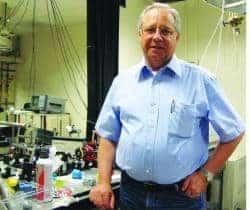Optogenetics techniques, which allow scientists to map and control nerve cells using light stimulation, are being used to study neural circuits in the brain with unprecedented precision. This revolutionary technology relies on light-sensitive proteins such as channelrhodopsins, and researchers at UC Santa Cruz have now determined the molecular mechanism involved in the light-induced activation of one of these proteins.
The new findings, published July 3 in two papers in the Journal of Biological Chemistry, can help scientists create tailor-made proteins optimized for use in optogenetics, said David Kliger, senior author of both papers and a professor of chemistry and biochemistry at UC Santa Cruz.
“Little was known about the functional mechanism of these proteins even though they are widely used in optogenetics,” Kliger said.
The researchers used fast laser spectroscopy to study the function of Channelrhodopsin-2, which is found in a type of marine algae and is widely used in optogenetics experiments. Channelrhodopsins are ion channels that control the flow of ions across cell membranes. There are many kinds of ion channels that serve different purposes in different types of cells. Nerve signals involve ion flow across the membranes of nerve cells, and the breakthrough of optogenetics was the discovery that inserting the genes for light-gated ion channels such as channelrhodopsin into neurons would make them fire in response to light.
The first paper describes the mechanism of channelrhodopsin function in terms of intermediate states the protein goes through in the process of opening the ion channel. In the second paper, the researchers showed that the mechanism revealed in the first paper can explain patterns of ion currents observed in optogenetics experiments.
“It is exciting because this opens up a methodology to start selecting mutant proteins with properties optimized for optogenetics, which is important for brain research and for studying neurological processes in general,” Kliger said.
There are several types of modifications that could be useful for optogenetics, such as making the proteins more efficient so that less light is needed to trigger currents in neurons, he said. In some cases, researchers might want to speed up the channel opening or slow it down, or they might want to speed up or slow down the channel closing. Depending on the tissues being studied, they might also want to shift the spectrum of light needed to activate the protein.
“These basic biophysics experiments can help in optimizing how the proteins function in optogenetics experiments,” Kliger said.
In addition to Kliger, the coauthors of the first paper are Istvan Szundi (first author), Eefei Chen, and Roberto Bogomolni at UC Santa Cruz and Hai Li and John Spudich at University of Texas Medical School in Houston. The coauthors of the second paper are Istvan Szundi and Roberto Bogomolni. This research was funded by the National Institutes of Health.


